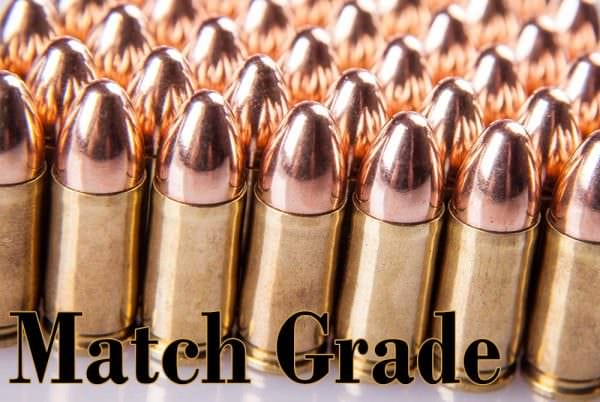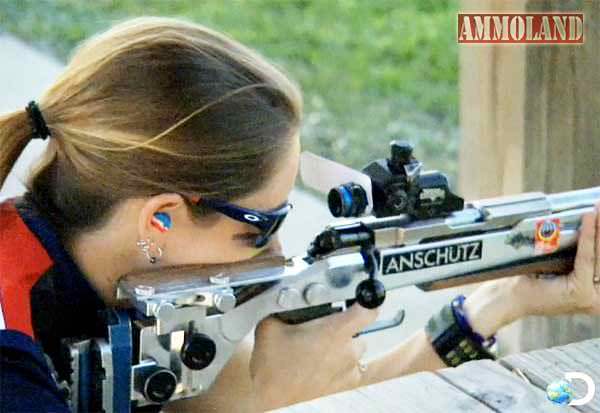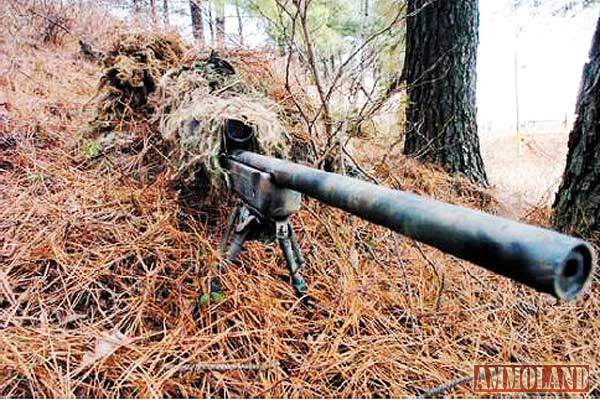by Sam Hoober
Match grade ammunition, match grade rifles? Alien Gear Holsters’ Sam Hoober debunks the phrase “match grade,” does the term have any useful meaning left?


USA – -(Ammoland.com)- The term “match grade” does get used a fair amount when it comes to both firearms, components and ammunition. Does it actually mean anything, or for that matter, does it mean anything anymore?
It’s something to wonder about prior to spending money on anything labeled “match grade,” be it a target rifle, hunting rifle, or concealed carry gun you intend to put in a gun holster.
What The Dictionary Says About Match Grade
According to the Wiki guys, “match grade” firearms, components or match grade ammunition is/are firearms, components and ammunition machined with far greater precision than typical guns, components or ammunition is. (Such ammunition would ostensibly be hand-turned brass or at least very well could be.) As a result, anything match grade would have much tighter tolerances and would be far more accurate than the typical gun you get in your LGS (local gun shop).
Match grade products are made for the purposes of competitive shooting matches. Since the utmost of accuracy is needed, a gun, it’s components and ammunition have to be up to higher standards. Naturally, this would also extend to military and police snipers as lives depend on their shots being made.
It’s kind of like race-spec equipment on a motor vehicle. Formula 1 cars, for instance, have such tight tolerances that the engine is actually seized at room temperature; they have to warm them up by other means (pumping hot water around the engine compartment) before starting them.
Some hold the match grade definition goes further, and that there are actual tolerance specifications for barrels, ammunition and so on, though it depends on whom you ask. (It isn’t as if the Office of Weights and Measures maintains standards on what constitutes “match grade.”)

For instance, Shilen Rifles specifies that the bore of their match grade barrels cannot vary more than .0005″ over the entire length of the barrel. Another company, Lilja, specifies no more than 0.0001″ variation is acceptable for their standard stainless steel match-grade barrels.
Ammunition manufacturers likewise have different standards; some may find one batch is a bit more accurate than others. They label it “match” and call it good. Others have a whole other process. In some instances, the brass, propellant and primer may be the same but a better projectile is used, in some cases it’s the propellant and projectile and in others still it’s precision-machined round made with the best materials from the ground up.
As a result, it can be safely said that while tighter tolerances (and perhaps better materials) are involved, the exact specifications of what makes something match grade varies, depending on whom is making it.
Is It Worth The Match Grade Premium?
With that all said, is it worth paying the match-grade premium? In truth…it depends.
Granted, some people just like to have premium products. A lot of people out there are perfectly content to put a S&W Shield in their concealed carry holster, but some people want to have a Wilson Combat, Chip McCormick or Les Baer pistol instead.
Consider what the firearm, component or ammunition is for. If you’re competing in shooting matches (whether pistol or long rifle) then it makes sense because many of these events require far more accuracy than the standard rifle or pistol is inherently capable of to score well. You need equipment that will help you win. After all, you don’t run a draft horse in the Kentucky Derby.
For the amateur long range or bullseye shooter that wants the utmost in precision shooting and doesn’t mind spending, it might also be worth it for the same reasons.
Likewise, a military or police sniper needs the same for their profession. Lives depend on placing accurate shots and doing so at possibly great distances.
However, for some other applications, paying the premium may not be necessary, strictly speaking. The typical big game hunter or concealed carrier will likely have all their needs met with a standard quality firearm. What you find in the average gun store is likely going to be just fine for these purposes, so long as either is reasonably accurate and reliable.

About Sam Hoober
Sam Hoober is a contributing editor at Alien Gear Holsters, as well as for Bigfoot Gun Belts. He also writes weekly columns for Daily Caller and USA Carry.

perhaps my father was an extreme taskmaster, but ammo must be within 1/10th gr of or you can just but stock ammo. first trim the shell casing to one standard by keeping one casing as a model so you don’t have to worry about the batteries in your digital caliper. {still good to have}. then the powder charge must be weighed to 1/10th of a grain to insure the air to powder ratio is identical. at that point if you are using a quality projectile {bullet} it should land in the same place each time when placed in a vice.… Read more »
Sooo let me get this F1 engine stuff straight. Metals expand when heated and shrink when cooled so you warm up a F1 engine to loosen the tolerances? Makes absolutely no sense. They warm up the engines to increase the expansion of the metal to tighten up the gaskets and seals. Head gaskets are so thin and the tolerances are so tight they want to actually warm the car up to tighten everything so theres not blow by at startup. Some metal to metal surfaces dont even have a gasket.
over thinking, rebuilt many engines & still ignore those who think i’m going too far weighing powder to 1/10th grain powder and precision trimmed shell casings so the air to powder ratio is optimal. wouldn’t think of trusting anything less.
by the way, what metal to metal surfaces. even a dodge dart sees no metal to metal unless the oil is the noncontact surface. even in cam & crank shaft seals there is at least an oil barrier. I hope you understand ammo more than you do autos.
Ryan, if you know your cars like you know your cars…you probably don’t know cars:
https://www.carthrottle.com/post/5-reasons-why-you-cant-put-an-f1-engine-in-a-road-car/
Gotta warm up an F1 Engine to start it – the pistons and engine block can be made of different materials which expand and different rates, and the expansion rates of different shapes is different. You should probably Google stuff before you start criticizing others.
Thanks for the tips Cayman.
Anyone ever seen the F1 teams pump hot water into the engine bay to free up their seized racing engines?
Match grade ammo mean for the most part that they put just enough powder for the round. You get less unburnt powder and less recoil more consistent velocity and tragectary
Match, field, or any other label = 10 times more expensive.
Match grade= 10 times more expensive.
People ASSUME that ammunition labeled “MATCH GRADE” is going to be more accurate than ordinary ammo – and sometimes it is, if it comes from a major manufacturer and uses something like a Sierra Matchking bullet – an example would be Federal Gold Medal .308. Unfortunately, today it seems to be mostly a marketing term (like the word TACTICAL) and is slapped on ordinary ammo to justify a higher price.
boxes my eye. if you don’t reload your own mesures it’s on you.
Match grade, field grade, plinker grade.
I just want to be able to put the round, where I want the round to go.
Names are just that, names.
Eric said it best.
trim your cases to the exact same length, it will take time to learn that part. optimum powder load follows. once you learn these things the powder charge is next. then trim to exact specifications. for example for a 9mm lugar I’ve found that 1.149 shell trim & 6.2 grains of power pistol propellant with a Hornaday xtp 115gr. hollow point will not let you down. there is little room for more propellant but an automatic needs more powder to work the action unless it’s an early savage 1907 or 1917. I can’t believe colt got the contract, Edison v.s.… Read more »
To me “match grade” means highest quality components and very high consistency in all metrics of the ammunition to include actual assembly and handling that doesn’t negatively affect aforementioned activities. The problem is in reality the difference between “match” and “field” grade is often only an incremental improvement often overshadowed by poor shooting habits or imprecise equipment. In other words, all my hand loaded ammunition is match grade except for those rare rounds that don’t shoot very well. Those non “match” are either “test” rounds or “field” grade. And since I make it, even cast my own boolits, my ammunition… Read more »
Let’s be clear- there is no “standard” that specifies what “match grade” means. Buyer beware.
Tolerance and clearance are NOT the same thing. F1 engines are HIGH tolerance and TIGHT clearance. A gun can be very sloppy and very tight tolerance. Tolerance gives you consistency, that’s it.
While there are undoubtedly some firearms that aren’t inherently accurate enough to warrant “match grade” ammo, and some match grade ammo is nothing more than “white box” plus premium bullet (as is some hunting ammo – and when the trophy of a lifetime is on the line, why shoot cheap bullets even if accuracy is “minute of deer”), there is most definitely the OPPOSITE of match grade. Example: Standard M4ogery. Shoots bulk 5.56 ammo into 2-2.5″ groups at 100 yards with chrono ES of 100 and SD of 35FPS. Hornady premium match ammo easily does 1.25″ all day with a… Read more »
“My 40S&W Springfield XDM 5.25 (match barrel) endured a double charge w/case separation. The frame and extractor needed replacement after the “boom”. The barrel had no deformation. And is still in-use.”
That has nothing to do with “match grade,” even though it speaks well of the bbl.
Whether or not a firearm or ammunition is “match grade” has to do with accuracy, not durability.
I think match grade is whatever the manufacturer says it is and that is the problem. I see the term match grade used frequently but there is no supporting information (for example, all match grade ammo has the same tolerances, powder by weight and projectile weight to some specified percentage). Almost every rifle I see guarantees 1 MOA accuracy or better. To me thats just good manufacturing, but its not match grade. To each their own.
“Only accurate rifles are interesting”.
Colonel Townsend Whelen
I was pleased that my Savage 10FP 308 was able to shoot all day off the bench at 100 yards and still be able to cover the entire group with a quarter. This was with ammo crafted for that rifle..
My 40S&W Springfield XDM 5.25 (match barrel) endured a double charge w/case separation. The frame and extractor needed replacement after the “boom”. The barrel had no deformation. And is still in-use.
In a previous life I worked to .0003″ tolerances, IMHO anybody that says they can hold .0005 or .0001 over the length of a barrel is full of it. Simple thermal variations will distort more than that.